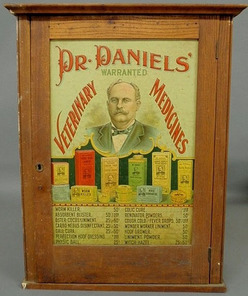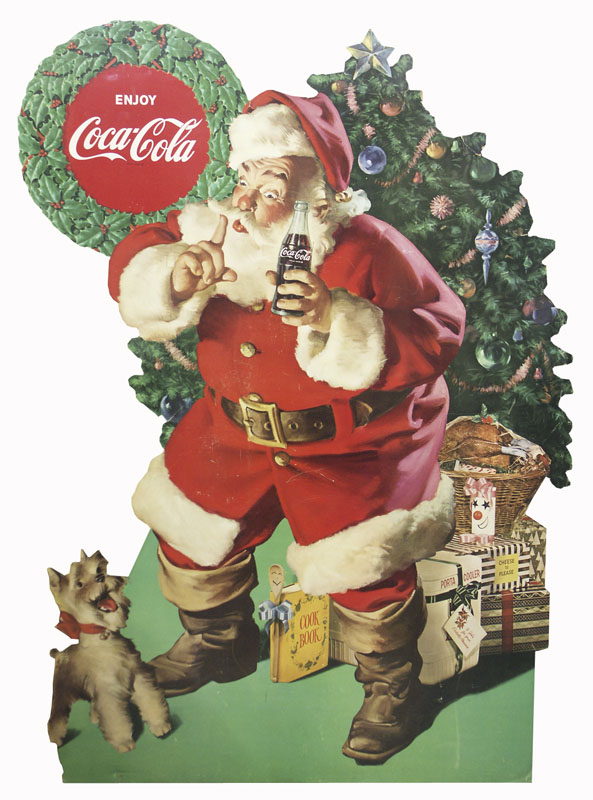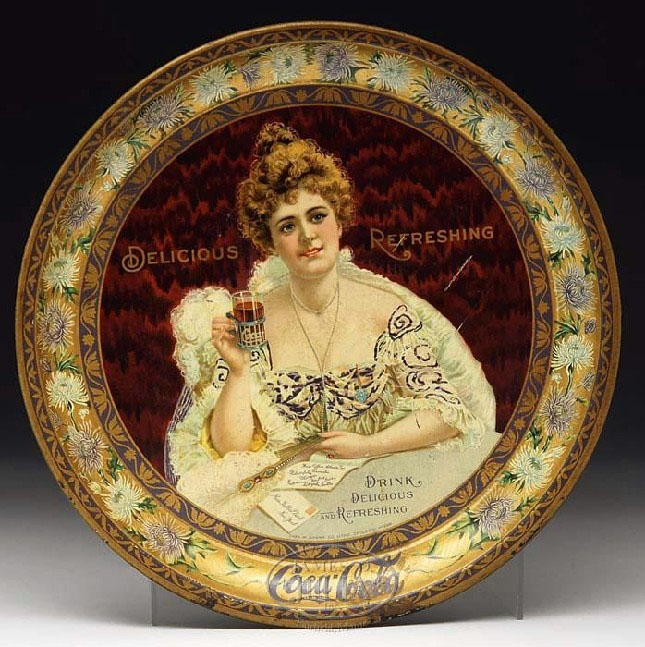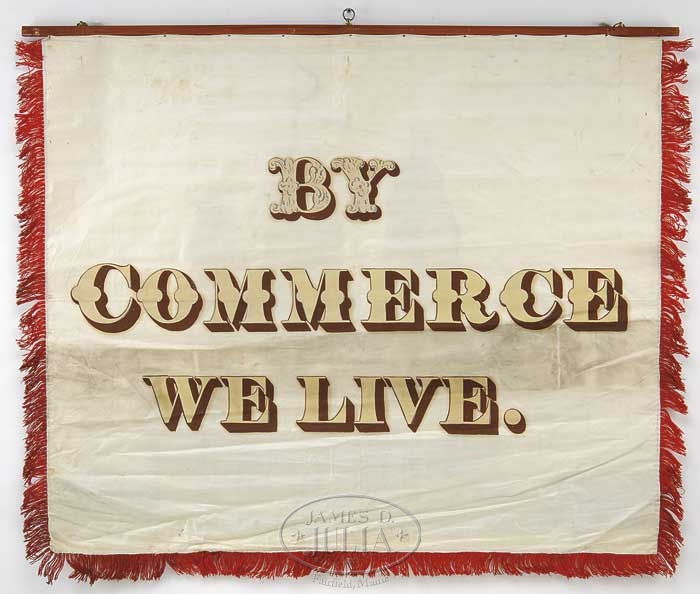One of the most common questions in the antiques marketplace is, “What’s hot right now?” At Prices4Antiques, we always see lots of searches for country store items, the kind of things that lined the counters and shelves of old general stores, and in the past seven days, we’ve seen searches for a National Cash Register Model 542 register with an oak base, a Nelson Baby Powder tin, an Enterprise Manufacturing Company countertop coffee grinder, a Coca-Cola barrel-form dispenser, and a Dr. Daniels’ veterinary medicine cabinet. These were the top five items viewed in our country store category this week, but people searched for thousands of other antiques and collectibles at Prices4Antiques.
You are currently browsing the archive for the Advertising category.
One of the most common questions in the antiques marketplace is, “What’s hot right now?” At Prices4Antiques, we always see lots of searches for advertising and in the past seven days, we’ve seen searches for a Shell Gasoline milk glass pump globe, a Coca-Cola bullet-style trash can, a McDonald’s countertop display of a Lego Ronald McDonald, an Old Gold Cigarettes tin sign, and an Anheuser-Busch lithograph of “Custer’s Last Fight.” These were the top five items viewed in our advertising section this week, but people searched for thousands of other antiques and collectibles at Prices4Antiques.
Coca-Cola is one of the most widely advertised products in the history of American manufacturing, and if the possibilities for collectors are almost unlimited, so is the potential for misleading the novice with fakes and reproductions.
Pharmacist J.S. Pemberton developed the formula for Coca-Cola in 1886, and for the past 122 years, Coca-Cola advertising products have hit the streets in record numbers and quantities. The Coca-Cola Company has mounted some of the most successful advertising campaigns not only in this country, but all over the globe.
Santa Claus by Coke
From the very start, the company projected an image of wholesomeness and patriotism. Early print advertisements featured beautiful women, adorable children, and winsome teenagers; some simply enjoyed a refreshing glassful, and for others it was a much needed thirst quencher and energizer during wholesome American activities including motoring, swimming, golfing, diving, and skating. Coca-Cola advertising was so ubiquitous, that Santa Claus, as we know him today, is the result of a 1931 Coke campaign designed by illustrator Haddon Sunblom, who modeled the “Jolly Old Elf” after himself. From 1931 to 1966, Sunblom’s Santa was the star of Coca-Colas seasonal advertising, and to this day informs the American ideal of Santa Claus.
Coca-Cola Collectibles by the Score
Coca-Cola advertising items and memorabilia include: combs, mirrors, knives, forks, calendars, thermometers, plates, checker sets, stuffed animals, T-shirts, caps, Olympic pins, cutlery sets, night lights, door knobs, syrup cans, dolls, fans, ice picks, puzzles, thermometers, signs, mugs, yo-yos, toy trucks, toy planes, bicycle lights, cookie jars, napkin holders, sheet music, clocks, cups, glasses, playing cards, coolers, die-cuts, figurines, bottle openers, medallions, pin backs, radios, scarves, ashtrays, bats, bingo cards, rulers, key chains, salt & peppers, blotters, toy telescopes, carriers, syrup jugs, jump ropes, menus & menu boards, carriers, vending machines, signs, and trays.
Authentic Coke Trays
The trays are the biggest single category, with at least 47 versions manufactured over the years. The oldest trays are not surprisingly, the most valuable, with the 1903 serving tray with an image of Hilda Clark (pictured) being one of the most valuable. While it’s not difficult to find most of the trays, people used them and wet glasses of refreshing Coke created lots of damage and rust. Mint condition trays are unusual, and command high prices. Prices for the common trays from the 1950’s and later have fallen substantially.
Reproduction Coke Trays
During the 1970’s when Americana was a popular decorating motif, Coca-Cola issued reproductions of some of their most popular early trays. These reproductions will be marked as such on the backs. In the 1980’s, they did the same, in honor of their 100th anniversary. While these are authentic, Coca-Cola issued trays, they are considerably less valuable than their antique and vintage counterparts.
-by p4A contributing editor Susan Cramer.
Reference & Further Recommended Reading:
To search the Prices4Antiques antiques reference database for valuation information on hundreds of thousands of antiques and fine art visit our homepage www.prices4antiques.com
So many historic events have strange beginnings and truth truly is stranger than fiction. Who would have believed that a drug-addicted Confederate soldier would create an elixir that would turn a generation into low-level cokeheads, help popularize the modern image of Santa Claus, and line the pockets of celebrities from Anita Bryant to 50 Cent? Seriously, I couldn’t make this stuff up!
John Pemberton, a wounded Civil War vet and trained pharmacist, was looking to supplant his morphine addiction when he started dabbling with the byproducts of the coca plant. After a reformulation to eliminate alcohol but not the coca, in 1886, 125 years ago in April, Pemberton created a concoction of coca extract and kola nuts to create Coca-Cola.
And the marketing machine kicked into gear almost immediately. (So did the cocaine, which wasn’t removed until 1903, but helped make the drink immensely popular. Even today, Coca-Cola includes a cocaine-free coca leaf extract.) From the very beginning, Coca-Cola has appeared in that familiar script, as it does on this early clock. While early advertising objects from Coca-Cola bring some of the biggest prices, the company had so many successful marketing campaigns that there’s a great deal available for a collector to choose from today. There are all sorts of giveaways with the Coca-Cola “It girl” of the moment (like the one pictured above on a pocket mirror) and fun things like Tarzan’s Tarzan and Jane (Johnny Weissmuller and Maureen O’Sullivan) enjoying a nice cold Coke. And Coke’s ad campaigns reflect the changing times; ads like this one take advantage of the company’s trend of advertising with beautiful young women to place a World War II female machinist front and center, while later signs reveal early efforts to target an African-American audience. With that iconic, cheerful red and the distinctive script, Coca-Cola advertising can refresh just about any collection!
-Hollie Davis, Senior Editor, p4A.com
To search the Prices4Antiques antiques reference database for valuation information on hundreds of thousands of antiques and fine art visit our homepage www.prices4antiques.com
Many records we enter are similar to other records and their value comes from enlarging part of the existing picture or offering more current market information, but occasionally auctions produce items that we haven’t even really encountered before. That’s when we all get excited! This happened just last month when an auction house in Maine offered a large collection of silk trade banners for sale, and these banners really are worthy of attention.
They come from an old Portland institution, the Maine Charitable Mechanic Association, which was founded in 1815 to help support and promote trades and to facilitate training and placement for apprentices. The trade picture in the United States at the time was a complex one. Just eight years before the formation of the MCMA, Jefferson had approved the Embargo Act of 1807 and just the year before the War of 1812, largely fought in response to a number of trade-related issues, ended, and all this prompted an increased focus on the old practices of trades and guilds.
To help promote and support tradesmen, one of the things the Maine Charitable Mechanic Association did was to commission the painting of a number of silk trade banners. In 1841, they hired William Capen, a decorative painter, to render depictions of a variety of local trades including hatters, painters, printers, and shipbuilders (pictured above). Capen painted most, but not all, of the group offered for sale. The banners were likely carried on occasion in parades and were clearly carefully handled, perhaps hanging on the walls of the MCMA’s meeting hall. Part of their value is due to a general excellent condition, as silk typically deteriorates significantly as it ages, separating into shreds and tatters without proper preservation. The banners were sold to benefit the MCMA, which still operates a library for members and offers a variety of educational events including lectures and classes.
-Hollie Davis, Senior Editor, p4A.com









